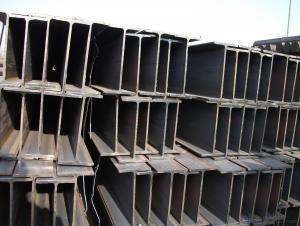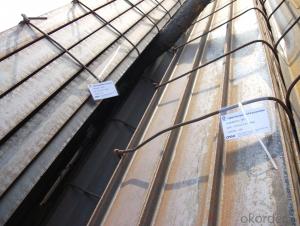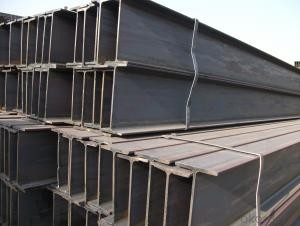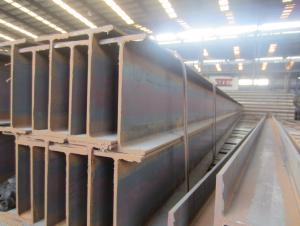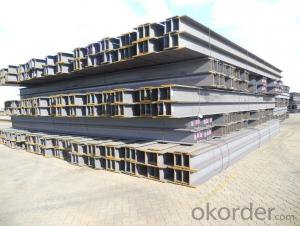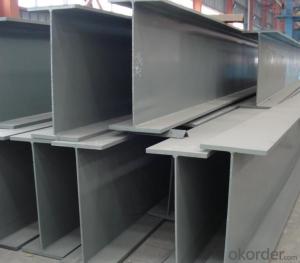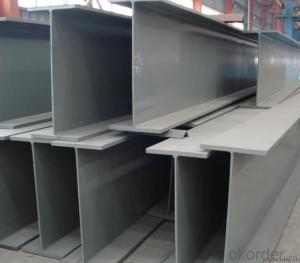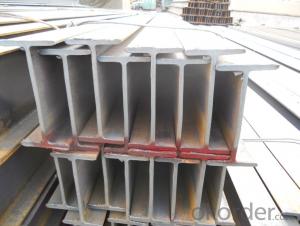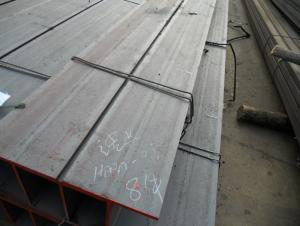H Type Bar Hot Rolled Steel Heb Bar H Iron Beam Steel
- Loading Port:
- Tianjin
- Payment Terms:
- TT or LC
- Min Order Qty:
- 27 m.t.
- Supply Capability:
- 20000 m.t./month
OKorder Service Pledge
OKorder Financial Service
You Might Also Like
Specifications
Hot Rolled Steel Heb Bar
1.Better price
2.Professional service
3.Mass stock
4.Fast delivery
H beam is widely used in various building structure and engineering structure:
a).used for the plant, high-rise building construction
b).used for the bridge, shipment building
c).used for lifting and transportation machinery, equipment manufacturing base building
d).used for the support, foundation pile manufacturing
Detailed description of H beam:
| Shape | H |
| Szie | 100x50x5x7---900x300x15x28,or as per your request |
| Standard (steel H beam) | GB/T3094-2000 GB/T6728-2002 ASTM A500 JIS G 3466 DIN EN 10210 |
| Material | Q195,Q235,Q345, 20#,45#,S235,S355,St37,St52,SS400 |
| Technique | Hot rolled,Cold Rolled,ERW,High-frequency welded,Extruded |
| Certification | CO;FE; MTC |
| Surface | Galvanized,Paint,Oil |
| Length | 5.8m (load into 20' container) 6m 11.8m(load into 40 container) 12m or according to customer's request |
| Uasge | Construction;Building;Ship building; |
| Port of Shipment | Shanghai;Tianjin |
| Main Market | Southeast Aisa;Middle East;Afica |
| Package | Seaworthy packing or according to your request |
| Productitity | 5000 ton per month;20000 ton per season |
| Pls noted | In order to make best quotation, Please kindly indicate length, width, thickness and the standard, material you required |
FAQ:
Q1: Why buy Materials & Equipment from OKorder.com?
A1: All products offered byOKorder.com are carefully selected from China's most reliable manufacturing enterprises. Through its ISO certifications, OKorder.com adheres to the highest standards and a commitment to supply chain safety and customer satisfaction.
Q2: How do we guarantee the quality of our products?
A2: We have established an advanced quality management system which conducts strict quality tests at every step, from raw materials to the final product. At the same time, we provide extensive follow-up service assurances as required.
Q3: How soon can we receive the product after purchase?
A3: Within three days of placing an order, we will begin production. The specific shipping date is dependent upon international and government factors, but is typically 7 to 10 workdays.
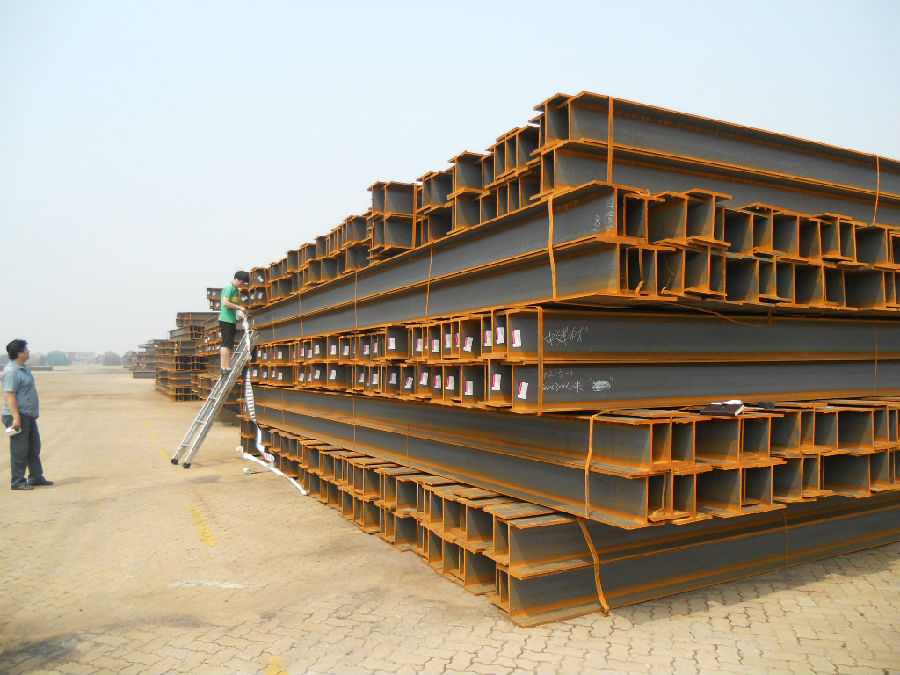
- Q:How do steel H-beams perform in terms of shear resistance?
- Steel H-beams perform exceptionally well in terms of shear resistance due to their structural shape and material strength. The H-beams, with their flanges and web, are designed to distribute and resist shear forces effectively. This configuration allows them to withstand heavy loads and lateral forces, making them highly reliable and suitable for applications where shear resistance is critical, such as in construction and engineering projects.
- Q:Can steel H-beams be used in wastewater treatment plants?
- Yes, steel H-beams can be used in wastewater treatment plants. They are commonly used in the construction of infrastructure such as tanks, channels, and supporting structures due to their durability, strength, and resistance to corrosion. Additionally, steel H-beams can be easily fabricated and installed, making them a suitable choice for wastewater treatment plant applications.
- Q:What is the maximum length of a steel H-beam that can be manufactured?
- The maximum length of a steel H-beam that can be made depends on various factors, including the manufacturing process, transportation limitations, and practical constraints. Concerning the manufacturing process, steel H-beams are typically produced in set lengths, which can vary depending on the specific steel mill or manufacturer. These standard lengths typically range from 20 to 60 feet (6 to 18 meters). However, it is worth noting that longer lengths can often be requested or fabricated based on specific project requirements. Transportation restrictions also play a significant role in determining the maximum length of a steel H-beam. The beam's length must be able to fit within the constraints of transportation methods such as trucks, trains, or ships. Each of these transportation methods has its own size limitations, and going beyond these limits may necessitate special arrangements, permits, or even partial disassembly of the beam. Lastly, practical limitations must be considered when determining the maximum length of a steel H-beam. Lengthier beams can pose challenges in terms of handling, maneuvering, and installation at construction sites. The weight and size of the beam can make transportation and lifting more difficult, potentially requiring specialized equipment or additional manpower. In conclusion, while there are standard lengths for steel H-beams, the maximum length that can be manufactured is influenced by the manufacturing process, transportation restrictions, and practical considerations. Custom orders, transportation logistics, and practical limitations all contribute to determining the maximum length of a steel H-beam.
- Q:How do Steel H-Beams contribute to the overall life cycle assessment of a structure?
- Steel H-Beams contribute significantly to the overall life cycle assessment of a structure by providing strength, stability, and durability. These beams are commonly used in construction due to their high load-bearing capacity, allowing for the design of lighter and more efficient structures. Additionally, steel is a highly recyclable material, which means H-Beams can be reused or recycled at the end of their lifespan, reducing the environmental impact. Overall, Steel H-Beams play a crucial role in enhancing the sustainability and longevity of a structure, making them a valuable component in its life cycle assessment.
- Q:What are the common challenges faced during the installation of steel H-beams?
- Several challenges may arise during the installation of steel H-beams. These challenges encompass the following: 1. Weight and size: The large and heavy nature of steel H-beams makes their handling and maneuvering during installation difficult. The transportation and positioning of these beams can prove challenging due to their weight and size. 2. Alignment: Ensuring proper alignment of H-beams is crucial for structural integrity. Achieving perfect vertical and horizontal alignment, particularly when dealing with multiple beams or long spans, can be challenging. 3. Connection methods: Securely connecting H-beams to other structural elements, such as columns or foundations, presents a challenge. The selection of an appropriate connection method and ensuring its proper execution require specialized knowledge and expertise. 4. Crane and equipment limitations: The installation of steel H-beams often necessitates the use of cranes and other heavy equipment. However, these machines have limitations in terms of lifting capacity, reach, and access to the construction site. Overcoming these limitations, especially in tight or congested areas, can be challenging. 5. Safety considerations: The installation of steel H-beams involves working at heights and handling heavy materials, thus raising safety concerns for the workers involved. Mitigating these risks necessitates the implementation of proper safety measures, such as fall protection, correct lifting techniques, and comprehensive training. 6. Site conditions: The condition of the construction site can also present challenges during the installation of steel H-beams. Uneven or unstable ground, restricted access, and adverse weather conditions can all affect the installation process, requiring additional planning and precautions. To overcome these challenges, it is crucial to have a well-coordinated plan, skilled personnel, and appropriate equipment. Engaging experienced professionals and facilitating effective communication among all parties involved can help address these challenges and ensure a successful installation of steel H-beams.
- Q:Are steel H-beams suitable for rooftop structures?
- Steel H-beams are indeed suitable for rooftop structures. Their strength and durability make them an excellent option for bearing heavy loads on rooftops. They can easily support various rooftop structures like solar panels, HVAC systems, and equipment. Moreover, steel H-beams offer exceptional structural support, guaranteeing the stability and safety of the rooftop structure. Furthermore, they possess corrosion resistance and a longer lifespan compared to alternative materials, establishing them as a dependable choice for rooftop applications.
- Q:Can steel H-beams be used for cantilever structures?
- Yes, steel H-beams can be used for cantilever structures. The structural properties of H-beams, such as their strength, stiffness, and ability to distribute loads, make them suitable for supporting cantilevered beams or structures that extend beyond their support points.
- Q:Can steel H-beams be used for supporting swimming pool enclosures?
- Yes, steel H-beams can be used for supporting swimming pool enclosures. Steel H-beams are commonly used in construction for their strength and durability. They provide excellent support and can withstand heavy loads, making them suitable for supporting swimming pool enclosures. Additionally, steel H-beams are resistant to corrosion, which is crucial in a swimming pool environment where they will be exposed to water and chemicals. However, it is important to consult with a structural engineer or a professional contractor to ensure that the size and specifications of the steel H-beams are appropriate for the specific requirements of the swimming pool enclosure.
- Q:What are the load distribution characteristics of steel H-beams?
- The load distribution characteristics of steel H-beams are primarily determined by the shape and design of the beam. H-beams, also known as I-beams or W-beams, have a distinctive cross-sectional shape that consists of two flanges connected by a web. This shape provides excellent load-bearing capabilities and allows for the efficient distribution of weight along the length of the beam. One of the key load distribution characteristics of steel H-beams is their ability to support heavy loads over long spans. The flanges, which are located at the top and bottom of the beam, are designed to resist bending and twisting forces, allowing the beam to carry substantial loads without excessive deflection. The load distribution along an H-beam is also influenced by the ratio of the flange width to the web depth. A wider flange width relative to the web depth results in a more distributed load, as the flanges can better resist lateral forces. Conversely, a narrower flange width relative to the web depth concentrates the load towards the center of the beam. Additionally, the load distribution characteristics of H-beams can be modified by varying the dimensions and material properties of the beam. By adjusting parameters such as the flange thickness, web height, and steel grade, engineers can tailor the load distribution capabilities of H-beams to meet specific structural requirements. Overall, steel H-beams are known for their excellent load distribution characteristics, making them a popular choice in construction and engineering applications where strong, durable, and efficient load-bearing capabilities are required.
- Q:Can steel H-beams be used for supporting conveyor systems?
- Indeed, steel H-beams possess the ability to support conveyor systems. In construction and industrial domains, these H-beams are widely utilized owing to their exceptional strength and durability. They offer unparalleled assistance in bearing heavy loads and can endure the weight and vibrations inherent in conveyor systems. Moreover, their structure facilitates effortless attachment of other essential components and accessories necessary for conveyor installation. Nevertheless, it is crucial to ascertain that the chosen steel H-beam satisfies the prescribed load-bearing capacity and is appropriately engineered and installed to guarantee the safety and steadfastness of the conveyor system.
1. Manufacturer Overview |
|
|---|---|
| Location | |
| Year Established | |
| Annual Output Value | |
| Main Markets | |
| Company Certifications | |
2. Manufacturer Certificates |
|
|---|---|
| a) Certification Name | |
| Range | |
| Reference | |
| Validity Period | |
3. Manufacturer Capability |
|
|---|---|
| a)Trade Capacity | |
| Nearest Port | |
| Export Percentage | |
| No.of Employees in Trade Department | |
| Language Spoken: | |
| b)Factory Information | |
| Factory Size: | |
| No. of Production Lines | |
| Contract Manufacturing | |
| Product Price Range | |
Send your message to us
H Type Bar Hot Rolled Steel Heb Bar H Iron Beam Steel
- Loading Port:
- Tianjin
- Payment Terms:
- TT or LC
- Min Order Qty:
- 27 m.t.
- Supply Capability:
- 20000 m.t./month
OKorder Service Pledge
OKorder Financial Service
Similar products
New products
Hot products
Hot Searches
Related keywords
